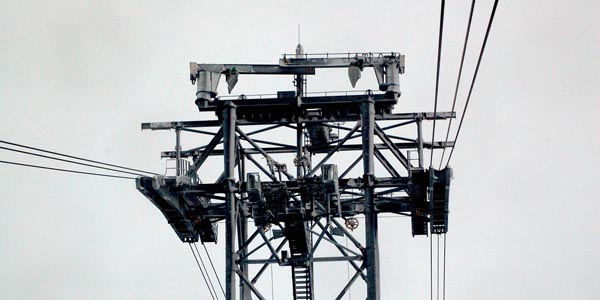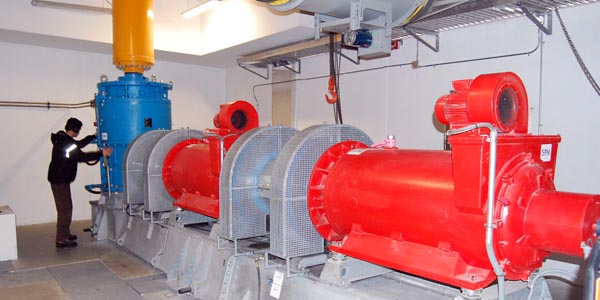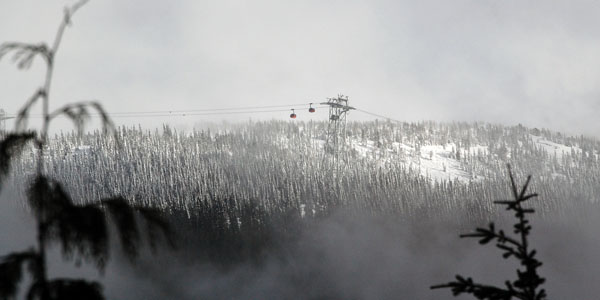Last month I toured Whistler’s Peak 2 Peak cable gondola system. This is Part 3 of a 3-part series on the system. Click on the following links to view Part 1 and Part 2.
Most aerial cable systems offer a smooth ride. What little friction there is, is rarely felt by the rider. Except, of course, when it comes to passing over towers. When passing over the sheave assemblies attached to these towers, riders tend to feel a noticeable bumpiness and accompanying noise. To some, it can be slightly unnerving. The older and more basic the system, the more pronounced this is.
The Peak 2 Peak’s 3S technology does away with these nuisances. When passing over the towers, there is virtually no change in noise level nor smoothness of ride. The engineers should be commended for this feat. Not only does it make the ride more pleasant, it makes the technology more palatable to the psychological fears of riders not accustomed to cable technologies.
The towers are, however, quite large compared to less advanced systems. This is partly due to the technology in question but also partly due to the distance between towers. At it’s most extreme, 3 km of ropes, vehicles and skiers are supported by only two intermediary towers. It’s an engineering marvel, but means the towers are giants. The four intermediary towers range between 35 to 65 metres in height!
(Such tower heights would be too large for an urban environment unless extreme design changes are made. Granted, I can think of only a few urban situations where a 3 km towerless span would be required.)
As I said earlier, everything about the Peak 2 Peak feels oversized and enormous. Use whatever superlative you like, it probably applies to the Peak 2 Peak.
Except when it comes to the engine.
I’ve seen my fair share of cable transit engine rooms and they’re almost always underwhelming. One sees these massive systems and one expects a corresponding engine room. That expectation almost never meets reality. The Peak 2 Peak is no different.
The Peak 2 Peak’s main engine and drive is located beneath the station in a bland, white subterranean room. The sound of the engine is deafening, but the engine itself is nothing much to behold. Despite it’s fire engine red coat of paint, the machine is unassuming. It’s small enough to fit inside a streetcar with room to spare for a half dozen riders and their backpacks.
That this piece of equipment moves 18 km’s of steel cable, 28 vehicles, 4,100 passengers and a steel bullwheel is remarkable. In fact, it’s almost unbelievable. What’s even more unbelievable is the diesel backup engine. The back-up is less than half the size of the main drive but can switch on within seconds of a main engine failure.
Redundancy is the name of the game here.
Of course the engine doesn’t do all the work. Gravity does much of it. The “belly” (I love that term) or sag of the rope is significant, on the order of three or four hundred metres. As maintenance engineer Sean Duff explained to me, the belly of the rope allows the system to capture potential energy (gravity) and use it to its advantage. Vehicles descending the belly pull vehicles up the belly. The engine only has to provide enough energy to compensate for the difference.
According to Sean, it’s an incredibly efficient system.
Because the Peak 2 Peak is a horizontal system, Sean explained, the system actually uses less energy than do the other gondolas on Whistler Mountain. Whereas the other systems must typically drag hundreds of people up the hill (with very few people using the system to descend the hill), the Peak 2 Peak has a relatively constant load on both directions. This causes a counterbalancing effect which reduces energy consumption.
When, however, a system with more “vertical rise” has more people descending the lift than ascending, it’s not uncommon for engineers to witness energy consumption drop below zero. That is, the system is basically generating energy because the weight of the descending line is heavier than the weight of the ascending line.
It’s refreshing how accessible the system’s engineers and maintenance staff are. Part of that accessibility is due to their presence. Unlike other transit technologies, cable systems tend to have engineers and maintenance staff onsite at all times of operation. As more-and-more cable systems demand near round-the-clock service (especially in airports), long shut downs for maintenance are just not a possibility.
This has caused the cable industry to adopt a policy of preventative maintenance. Throughout the course of their workdays, cable engineers are not fixing problems after the fact, they’re preventing them from happening in the first place.
As I said in Part 1 of this series, I doubt the Peak 2 Peak was really meant for skiers. Skiers want to go from the top of a mountain to the bottom, not from the top of one mountain directly to the top of another. But that’s not really the point of the Peak 2 Peak.
Instead, the Peak 2 Peak is a statement of cable’s advances. Is it necessary? No. Is it overkill? Completely. But at a total cost of only $57 million, this overkill is still more cost-effective and deeply efficient compared to our traditional transit solutions.
It may be at a ski resort, but it’s transit through and through.




2 Comments
How much Horse Power is the main drive motor, and the back up motor? Also what terminal is all of this at?
Andrew,
The main drive and the back-up is on Whistler with the return wheel on Blackcomb. I honestly don’t know what the Horse Power is of the drive motor.